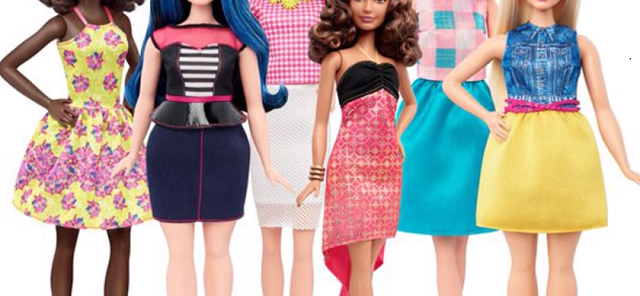
“My beloved child, break your heart no longer. Each time you judge yourself, you break your own heart.” ~ Swami Kripalu
I sat down for breakfast earlier this week and behold, the business section of the Chicago Tribune. Doth mine eyes deceive me?
“Barbie’s New Bods—Mattel looks to recharge sales as girl’s want a shift.”
Holy sh*t, this is big, really big.
Mattel, the maker of the ubiquitous plastic doll, has decided to revamp their iconic Barbie and offer three new body types. With sales down 4 percent last quarter, the company is scrambling to boost sales…and possibly the self-esteem of millions of children around the world.
Regardless of the motive—corporate greed or altruism—I am overjoyed with the presumptive psychological impact this is bound to have on future generations of girls and boys.
So what exactly am I going on about? Well, the three new Barbie body types are the following: Tall, Petite and Curvy; or in the language of Ayurveda: Vata, Pitta and Kapha.
For those unfamiliar with these terms, let me get you up to speed. Ayurveda is a nature based system that looks to the five elements: Ether, Air, Fire, Water and Earth. Together these elements combine to form the three doshas: Vata, Pitta and Kapha. Vata is composed of Ether and Air. Pitta is a blend of Fire and Water (Which may seem counter intuitive, but steam baby, steam!). Finally, Kapha is a combination of Earth and Water.
Over 5,000 years ago the Ayurvedic sages recognized the doshas as the three basic constitutions. Now before you start over-analyzing and compartmentalizing yourself once more, know this—we each have all five elements, therefore, we have all three doshas. I emphasize this point because as an Ayurvedic health consultant, it is quite common for someone to say to me: “I’m all freckly, I’m so Pitta” or “Look at my bubble butt. I am super Kapha.” I’m not saying this is wrong, but it is limiting.
Ayurveda sees each individual as a unique combination of VPK with different qualities being more prevalent depending on a multitude of factors, including genetics, ethnicity, details of conception (timing, climate and parent’s emotional state) and time and place of birth. The take away is that we are all three. Wash, rinse, repeat.
Each dosha has specific physical attributes. Vatas—composed of Ether and Air—tend to be wispy, leggy and have a difficult time gaining weight. Water lends a bit more heft to Pitta dosha, creating a middle-of-the-road body type. They often have a medium athletic build with average strength, however, the fire element makes them compact powerhouses. Lastly, we have the curvy, voluptuous Kapha. A combination of Earth and Water, Kapha is comprised of the two grossest elements—I mean gross as in dense, not repulsive, because Kaphas are anything but repulsive, they are love bugs!
Tall, petite and curvy, all three doshas are beautiful. Sadly, Kapha has become the most loathed and feared dosha, while Vata has been glorified for the last few decades.
“I’m not thin enough.”
“Argh, these hips!”
“OMG, I have cellulite and a muffin-top!”
I’m here to tell you the following:
1. You are perfect as is.
2. Accept your genetic gifts. The more you deny who you are, the less happy you’ll be.
3. Love yourself and others.
So without getting too Pollyanna on you, here are the positive attributes of all three doshas:
Vatas are enthusiastic and excitable, the social butterflies. Artistic and speedy, Vatas tend to be more ethereal and in touch with the great beyond—they may even “see dead people.”
Pittas get things done. They are the business men and women of the world—strong, sharp intellect, witty and efficient.
Kapha is robust and strong, the deeply-loving and kind mama and papa bear. They have a tendency to hold onto weight, but that is not always a bad thing. Classic Ayurvedic texts recognized a total of 140 diseases and categorized each with a specific dosha. Vata had 80, Pitta 40 and Kapha, only 20. It takes a lot for Kapha’s to get sick; they are like the sturdy, reliable, wooden-paneled station wagon your parents insisted on driving for years.
Dr. John Douillard’s provided a great analogy of VPK during the Paleolithic era: Vata caveman would be drawing on the cave wall; Kapha caveman would be daydreaming about ways in which the cave could be cozier; and Pitta caveman would be out hunting and harnessing fire. Vata innovates, Kapha takes care of the spawn and Pitta gets sh*t done. Human evolution y’all.
Skeptical of Indian Medicine? How about mid-century discoveries from our Ivy League institutions? Harvard Psychologist William Sheldon created a similar system in the 1940s, classifying Mattel’s revolutionary three body types as Ectomorph (tall), Mesomorph (petite) and Endomorph (curvy).
Ectomorphs are thin, flat chested with fragile sensitive bodies. They are dominated by the central nervous system. Mesomorphs are hard, dominated by muscles and thicker skin, but can be insensitive. Endomorophs are soft, store and gain weight easily, and are the least affected by external stimuli.
Hmm, this sounds so familiar, where have I read this? Yes, you guessed it! Perhaps it was intuition or he was an Ayurvedic physician in a previous life, but what Sheldon rediscovered—and Mattel has revolutionized—is the westernization of the three doshas: Tall/Ectomorph/Vata, Petite/Mesomorph/Pitta and Curvy/Endomorph/Kapha.
Hari Om, throw down the mic.
Can you now see why I’m bursting with excitement over this headline? Perhaps it is premature to shout from the mountain tops, but from my perspective, it appears that the Eastern and Western worlds are slowly beginning to meld back together and it’s inspiring.
Mattel’s designers and marketing advisers have finally heard the people’s cries and recognized the need for a shift in how we present the human body to the world. Instead of boxing every male and female into an unobtainable Ken or Barbie mold, they are finally giving us permission to be unapologetically ourselves. Sheldon attempted to teach self-acceptance back in the 1940s, just as Ayurveda did 5,000 years ago and honestly, I don’t care how the message gets out. If it has to be through a plastic doll, so be it.
What warms my heart and gives me hope, is that Barbie has been given a body boosting upgrade. Curvy, Tall, Petite—all good. It’s as if Mattel went into the home of every little boy and girl and scribbled across the threshold “You Are Enough.”
Author: Lauren Sauer
Editor: Nicole Cameron
Image: YouTube screenshot






Read 5 comments and reply